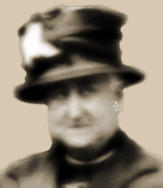Blindingly obvious
You can still see the holes where the name of this building used to be, but the letters themselves are long gone.
The lack of any obvious identifiying marks doesn't pose an insuperable problem to someone who has recently purchased a copy of Terry Cavanagh's "Public Sculpture of Liverpool", though. Oh, no. This Grade II listed building was designed to house the Liverpool School for the Blind.
Mr Cavanagh reports that, according to Architect and Building News dated 7th of October 1932, the subjects of the sculptural reliefs "relate to the life and work of the school". One of the reliefs depicts hands reading Braille. If that had been the one I saw first, I might at that point have been feeling fairly sanguine about what the school had to offer.
Unfortunately, one glance at the rest of the reliefs leads one to suspect that the main purpose of the school was to provide the tragic blindies of the time with skills they could employ in their praiseworthy quest to avoid being an economic drain on the rest of society.
Blind people could, apparently, knit. (I know: isn't that clever of them? I bet some kindly, sighted person helped them with the colours, though, don't you?)
Evidently - given that two of the reliefs are devoted to this - blindies were also absolutely top-tastic at making brushes. Which, y'know, to me sounds like a fulfilling and intellectually-stimulating full-time job. I mean, who wouldn't want to make brushes for a living, if they had the choice?
And then there's the predictable relief of hands playing a piano, because everyone knows that blind people are all perfectly suited to a life of tuning pianos, what with the absence of sight having blessed them with almost superhuman hearing and everything.
So, if you're a tragic blindy in 1930s Liverpool, you have a choice of careers. You can knit for a living (although presumably only if you are a girl); you can make fabulous brushes; or you can utilise your enhanced sense of hearing to help you tune pianos.
But that's not all! No, they saved the best (and most stereotypical) of all possible crip occupations for pride of place above the front door.

Yes, that relief really does depict basket-weaving.
I came pretty close to backing off the pavement into the path of oncoming traffic in shock when I saw that. The threat of basket-weaving is such a crip in-joke standard these days that it's a bit bloody chilling to realise that, less than 80 years ago, it was so very far from being a joke that it was actually celebrated in architecture. I wonder how many brilliant minds were thrown away on a lifetime of bending willow for no better reason than that their owners couldn't see...?
The Editor











1 Comments:
I shall give up IT geekery at once and start making trugs, being I'm a tragic cripple and all.
Post a Comment
<< Home